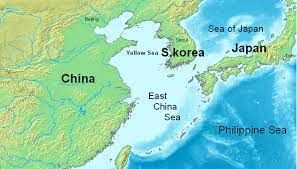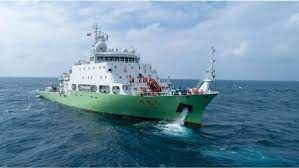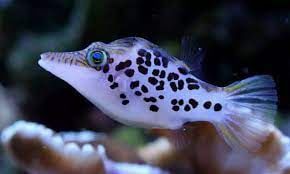UPSC Daily Current Affairs- 28th October 2023 | Current Affairs & Hindu Analysis: Daily, Weekly & Monthly PDF Download
| Table of contents |

|
| Women can make the world better |

|
| East China Sea |

|
| TN experience on Caste Survey |

|
| Shi Yan 6 |

|
| Calixcoca Vaccine |

|
| Leopard Toby Puffer Fish |

|
GS-I
Women can make the world better
Subject: Social Issues

Why in News?
The article highlights Arun Maira’s insights on the gender disparity in economic narratives, emphasizing the undervaluation of women’s contributions, the evolving challenges in global employment patterns, and the need for a more inclusive and care-focused approach to economic development, particularly in the context of India and the G-20’s call for a holistic vision beyond GDP
Challenges in How We See Money and Work:
- Not Enough Women Recognized: The Nobel Prize in Economics mostly goes to men, leaving out women’s important contributions. Only three women have won it so far.
- Forgetting the Value of Care: The work women do at home, taking care of family and community, isn’t seen as important for the economy. This is a big problem.
- Jobs Changing Globally: The way people work is changing worldwide. More jobs are now short-term or in the gig economy. This is a big challenge for India, which has a lot of young people.
- Not Paying Enough for Important Jobs: Jobs like taking care of families or working in health and education are crucial, but the people doing these jobs, mostly women, are not paid well.
India’s Economic Situation:
- Problems for Young People: In India, even though the economy is growing fast, it’s hard for young people to find good jobs with good pay and security.
- Need More Focus on Care: India ranks 132nd in human development, and we need to spend more on services that take care of people. But sadly, jobs like taking care of families or working in health and education are not paid much.
- G-20’s Call for a Different Way: Our Prime Minister has asked the G-20 for a new approach, one that looks beyond just making money. He says it’s time to think of the world as one family.
Checking How Well We’re Doing:
- Progress Slow for Big Global Goals: The G-20 says we’re not doing great halfway to our big global goals. Only 12% of the things we wanted to achieve are on track.
- Time for a Big Change: Arun Maira says we need to change how we solve problems. The usual way is not working, so we need to try something new.
Seeing Economics in a New Way:
- Thinking About Everyone: Maira says we need to change how we see our economy. It’s not just about making things and competing. It’s about taking care of people.
- Looking at What Women Do: Women, according to Maira, do a lot of important work that isn’t always noticed. Nobel laureate Elinor Ostrom showed that when women are in charge, communities work well together.
What Needs to Change:
- Giving Women More Power: Maira says we need to let women shape how things work, not just follow what men have set up.
- Letting Local Communities Decide: Instead of having big experts decide everything, Maira says we should let local communities come up with their solutions. What works in one place might not work in another.
Conclusion:
Changing how we think about our economy is not easy, but it’s important. Maira tells us that we should listen to regular people, especially women, and let them help make things better. This way, we can build a future where everyone is taken care of, and our world becomes one big family.
Source: The Hindu
East China Sea
Subject: Geography

Why in News?
Japan's Foreign Ministry recently asked Google Inc. to revert the map names of disputed East China Sea islets to only using Japan's name.
About the East China Sea:
- It is an arm of the Western Pacific Ocean, located in East Asia.
- It covers an area of roughly 1,249,000 square kilometers (482,000 sq mi).
- It is situated between the eastern coast of China, including the Shanghai coast, and the southwestern coast of Japan, including the Ryukyu Islands.
- The Korean peninsula, China, Japan, and Taiwan lie within or border the East China Sea.
- The East China Sea and the South China Sea together form the China Sea.
- It connects with the Japan Sea via the Tsushima Strait and the South China Sea via the Taiwan Strait.
- Its northern extension between mainland China and the Korean Peninsula is the Yellow Sea.
- It is largely a shallow sea. The western edge of the sea is a continuation of the shelf that extends between the South China Sea and the Yellow Sea.
- Rivers: The Yellow River (Huanghe) and the Yangtze River (Changjiang) discharge into the East China Sea, providing much fresh water and suspended particles.
- Weather is dominated by the monsoon wind system, the result of differential heating between land and water.
- Islands: The sea contains several islands, with the most significant being the Ryukyu Islands, which are part of Japan, and the Diaoyu Islands (known as the Senkaku Islands in Japan), which are a source of territorial dispute between China and Japan.
Source: Indian Express
GS-II
TN experience on Caste Survey
Subject: Polity

Why in News?
The recent nationwide discussions on caste-based surveys and reservations have ignited debates regarding reservation limits.
- While many call for a similar census across India, Tamil Nadu’s history offers insights into the complexities of caste-based reservations.
- Despite previous efforts, the implementation of OBC (Other Backward Class) reservations remains a challenge in the state.
Genesis of Ramachandran Commission
- Background: The First BC panel (1969-70), led by A.N. Sattanathan, suggested raising BC reservations, but the idea of a creamy layer hasn’t gained political backing.
- Current Backdrop: In 1980, following electoral setbacks, the government in Tamil Nadu, led by M.G. Ramachandran, increased BC (Backward Class) reservations from 31% to 50%, totalling 68% with SC & ST reservations (later 69% with ST exclusive reservation).
- Legal Challenge: The move faced legal challenges, prompting the state government to form a commission to review BC enumeration and classification.
- Commission Formation: The Second BC Commission, chaired by J.A. Ambasankar, was established in late 1982 and submitted its report in February 1985.
Key Highlights of the Commission’s Work
- Socio-Educational-cum-Economic Survey: The Commission conducted a comprehensive door-to-door enumeration of BCs in two stages during 1983-84. Unlike the previous panel, which relied on the 1921 Census, this survey was based on contemporary data.
- Caste Classification: The Commission identified 298 BC communities within main groups such as BCs, Most BCs, Denotified Communities (DNCs), SCs, STs, and others. BCs constituted 67.15% of the state’s population.
- Educational Survey: A sample survey of students in schools and colleges was conducted, along with an assessment of BC representation in public services.
Key Recommendations
- Reservation Quantum Debate: Disagreements arose between Chairman Ambasankar and other members regarding the reservation percentage. While Ambasankar proposed reducing it to 32% to stay within the 50% limit, dissenting members argued for at least 50% due to the BC population’s size.
- Reservation Coverage: Differences also emerged regarding the coverage of reservations. Ambasankar suggested separate lists of BCs for Article 15(4) and Article 16(4), while members favored a single list.
Government Response and Legal Safeguards
- No Change in Reservation Quantum: The government retained the 50% BC reservation and did not accept Ambasankar’s recommendation to reduce it.
- Ninth Schedule: To safeguard the 69% quota, Tamil Nadu enacted a law and placed it under the Ninth Schedule following the Supreme Court’s Mandal Commission case judgment in 1992.
- Subsequent Changes: Over the years, separate quotas for Muslims and Christians were introduced within the BC reservation, but some were later withdrawn or challenged.
- SC Verdict: In 2021, the Supreme Court struck down a law providing 10.5% reservation for Vanniyars within the MBC quota, citing non-contemporaneous data from the Ambasankar panel.
Conclusion
- Tamil Nadu’s experience with caste-based reservations underscores the intricate challenges involved. While the state has maintained a high reservation percentage, debates over quantum and coverage persist.
- The recent legal developments highlight the importance of contemporary data in determining and sustaining reservations, making it a complex and evolving issue.
Source: The Hindu
GS-III
Shi Yan 6
Subject: Science and Technology

Why in News?
Recently, a Chinese research ship, Shi Yan 6 docked at Colombo port.
Background:-
- The Chinese research vessel ‘Shi Yan 6’ has stirred concerns due to its visit to Sri Lanka, with both the US and India voicing objections.
- Shi Yan 6 was given permission to enter the (Colombo) port for replenishment.
- US Under Secretary Victoria Nuland, who met Sri Lankan Foreign Minister Ali Sabry in New York on the sidelines of the UN General Assembly session, had reportedly raised concerns about the visit of ‘SHI YAN 6’.
Reasons behind India’s Object to Chinese Vessels Docking in Sri Lanka:-
- India’s objection to Chinese vessels docking in Sri Lanka stems from security concerns.
- India perceives Chinese ships in close proximity to its mainland as potential security threats, suspecting espionage activities even when their stated purpose is scientific research.
- This apprehension has led to objections to Chinese vessels docking in Sri Lankan ports.
China’s Statement on the matter:-
- China has maintained that the marine scientific research activities of Yuan Wang 5 and similar vessels align with international law and common practice and do not jeopardize the security or economic interests of any country.
Sri Lanka’s Response:-
- In response to the US’ concerns, the Sri Lankan Foreign Minister emphasized Sri Lanka’s commitment to neutrality.
About Shi Yan 6:-
- Shi Yan 6 is a Chinese Research/Survey Vessel.
- It has a carrying capacity of 1115 DWT (deadweight tonnage).
- Its current draught is reported to be 5.3 meters.
- It has an overall length of 90.6 meters and a width of 17 meters.
- This three-month voyage seeks to gather extensive fundamental data.
- It aims to study and uncover how dynamic processes impact the biogeochemical cycles, ecosystems, and sedimentary processes in the region.
- It wants to elucidate the geographical patterns of biodiversity, understand the response of biological communities to physical processes and gain insights into paleoclimate changes.
Source: Indian Express
Calixcoca Vaccine
Subject: Science and Technology

Why in News?
Recently, Brazil scientists developed a new ‘vaccine’ Calixcoca” Vaccine, for cocaine addiction.
About“Calixcoca” Vaccine:-
- Calixcoca’, is a therapeutic vaccine that promises to prevent the addictive effects of cocaine or crack.
- It is offering new hope to millions battling cocaine addiction worldwide.
Working:-
- Calixcoca functions by inducing an immune response that generates antibodies capable of binding to cocaine molecules in the bloodstream.
- This binding process results in the enlargement of cocaine molecules, rendering them too large to pass into the brain’s “reward centre” or mesolimbic system.
- This area of the brain is typically stimulated by cocaine to release dopamine, the pleasure-inducing neurotransmitter.
- Consequently, individuals who receive the vaccine will not experience the desired euphoric effects of cocaine, potentially assisting them in breaking the cycle of addiction.
- Furthermore, it reduces the risk of overdose as cocaine molecules are retained in the blood, bound to the antibodies, and thus, unable to act on the heart or arteries.
- Following encouraging results in animal trials, Calixcoca is poised to enter the next phase of development, which involves human trials.
- Calixcoca is designed for recovering addicts who have already discontinued cocaine use and are seeking assistance in maintaining their sobriety.
Significance:-
- Despite the alarming rise in cocaine and crack addiction, there are no approved medications specifically for treating this problem.
- The development of the Calixcoca vaccine, therefore, is a beacon of hope for an effective medical intervention.
Source: Indian Express
Leopard Toby Puffer Fish
Subject: Science and Technology

Why in News?
Recently, a "super rare" creature, the Leopard Toby Puffer Fish, that roams in the depths of the ocean, has been spotted off the coast of Australia.
About Leopard Toby Puffer Fish:
- It is a deepwater reef species that lives in deep water caves and reef slopes at an average depth of 50 to 100 meters.
- Scientific name: Canthigaster leoparda
- Appearance: It is characterised by clusters of black dots along the flanks of its pale body.
- It is also known as blowfish.
- Habitat: It is believed to have a thriving population in its deep-sea habitat.
- Puffer fish in general are known for their unique morphological appearance and features, especially their defensive mechanism of inflating and deflating.
- These small sea creatures pump water into their stomachs until they turn into the shape of a ball, larger than their normal body size, to evade predators.
- Distribution: It is usually found in the waters of the Philippines, Indonesia, Guam, and Micronesia.
- Conservation status
- IUCN: Least Concern
Source: The Hindu
|
55 videos|5389 docs|1141 tests
|
FAQs on UPSC Daily Current Affairs- 28th October 2023 - Current Affairs & Hindu Analysis: Daily, Weekly & Monthly
| 1. Can women really make the world better? |  |
| 2. What is the significance of the East China Sea? |  |
| 3. What is the TN experience on Caste Survey? |  |
| 4. What is the Calixcoca Vaccine? |  |
| 5. What is the Leopard Toby Puffer Fish? |  |















